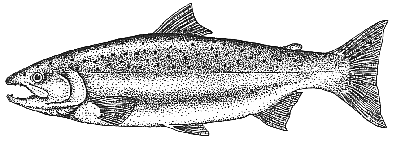
A Fisherman Looks at Coho Salmon
-by
D.C. Reid
illustrations - Barb Krimmer
Second largest of the Pacific salmon, coho (also known as bluebacks and silvers) attain adult weights of 10 - 20 pounds. Caught in 1947, the largest ocean-caught coho weighed in at 31 pounds. This record may soon be beaten by fish from the Great Lakes; introduced to these freshwater 'oceans' some decades ago, coho numbers have flourished.

Unlike chinook that migrate long distances up large rivers, coho, the other resident salmon in British Columbia waters, spawn in late fall in one of 800 short coastal streams and rivers. Females lay 2000 - 4000 eggs, and alevins hatch in 47 - 65 days. Fry coho do not migrate to sea immediately. Instead they reside in their coastal stream for 12 - 24 months. Stream survival relates directly to water quality, temperature and food supply. Accordingly, due to their long freshwater residence, coho numbers inversely correlate with watershed disturbances such as suburban development and logging activities. Normally spawning at three years of age, returning coho may be 2 - 3 years old, allowing for some cross-fertilization across brood years.
Coho begin their saltwater life in April to July as 12 -14 inch grilse of legal size (30 cm). They move northward along the coast then return to take up residence in inland waters as one- to three-pound bluebacks for the months of November to April. Thus they, along with their larger cousins, chinook, are one of only two species present and considered resident salmon in periods other than the summer migratory period. In late spring, these fish move northward and disperse into the open Pacific for the summer. Coho then reassemble in migratory schools that enter sport fishing waters in successive waves from July through October. Highly sensitive to freshwater concentrations, these fish provide excellent fishing near spawning rivers until the drenching rains of late fall.
Visually, coho may be distinguished easily from other salmonids. Younger bluebacks sport beautiful blue-green colouration in winter months. Whether immature or adult, coho have white upper jaws filled with sharp, herring-shredding teeth. True carnivores - a characteristic shared only with chinook - coho flesh is a lovely deep magenta, reflecting the high proportion of euphasiid shrimp in their diets.
Adult coho colouration varies from blue to gun-barrel grey. Other defining features include bright silver flank colouration, tightly-packed scales and slight black dotting of dorsal surfaces. Dots seldom extend into the tail, which, in shape, is shorter, stubbier and less-deeply 'V'd than that of a chinook. Tail rays are prominent. Placed beside chinook, coho appear decidedly grey and slightly coarse. Secondarily, coho may be distinguished by 18 - 26 stubby, smooth, widely-spaced gill rakers.
Despite any imperfection in appearance, coho make for pure angling pleasure. Summer coho gorge themselves en route to the spawning rivers, gaining as much as 1 pound per week. Herring balls - schools of herring tightly bunched against the surface and attacked from below by salmon, as well as from above by seagulls and cormorants - signal the presence of coho. These noisy patches of commotion form and reform across the fishing grounds and represent excellent fishing opportunities, particularly for drift and fly fishing methods. The trapeze artists of the salmonid world, hooked coho spend as much time in the air as in the water. A salmon that leaps behind the boat one second then reappears in front of the boat then veers off to another side with fisher in hot pursuit, almost invariably turns out to be a coho. Expect that zing of adrenaline when coho fishing; the most typical bite is the smash and run pattern, guaranteed to wake up the most blase on board.
Experienced fishers know to consider coho behaviour. Typically, summer runs occupy the first 0 - 50 feet 1 - 3 miles offshore. Tidelines, where streams of water meet forming visible currents or surface chop, spell food to hungry coho. Passively floating plankton - the larval stages of plant and animal life - are moved into tidelines and baitfish follow. Tightly schooling by nature, coho key in on baitfish and fishers concentrate their effort on the "moving" side, ie., the side where current is strongest. Coho migrate in small schools of 50 - 100 fish swimming purposefully home, almost touching one another's flanks. Hence there may be many schools of coho on any particular fishing ground, each pursuing a localized cloud of bait or shrimp.
Winter bluebacks often differ in behaviour. Freshly emerged from freshwater, blueback schools disperse in offshore areas. Like their older brethern, school location bears little relation to underwater structure; however, schools of bluebacks inhabit depths of 100 to 130 feet in many areas. Whether for winter-resident or summer-run fish, fishing success relates to staying in contact with a school. Establish bearings the moment a coho smacks the lure and return to that exact spot as quickly as possible.
Voraciously carnivorous as adults, and even more eager as bluebacks, coho prefer trolled bait, the most commonly utilized being anchovy in a teaserhead, cutplug herring and herring strip. Silver or green spoons work well in winter, with red spoons taking over in late summer when the infrared spectrum begins to dominate the sky. Shortish 20- to 30- inch leaders for hootchies are recommended. Flashers tend to outfish dodgers. Any of the lead drift fishing lures produce in summer. Tackle boxes should contain at minimum a white and grey buzz bomb and a green stingsilda. Euphasid shrimp appear pink and therefore, lures with pink shading should be favoured. For real excitement, fly fish kelp beds where newly-hatched herring dimple the evening surface.
More information on Coho Salmon & other
Game Fish
of B.C.
|




